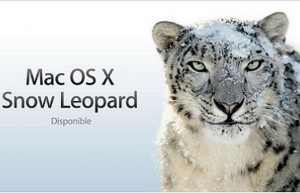 This is the first in a 3-part overview of Apple’s new operating system, with the other parts to be published over the next two days. In this first part, he looks at the installation process, the desktop and Finder, as well as some of the utility applications that Leopard features.
This is the first in a 3-part overview of Apple’s new operating system, with the other parts to be published over the next two days. In this first part, he looks at the installation process, the desktop and Finder, as well as some of the utility applications that Leopard features.
It’s no surprise to anyone that Apple took their time on this one. They said after Tiger they would be lengthening the time between releases. Has Apple done good in that time though? The short answer is "Oh my God yes".
Price approx
$ 199
Software/Hardware Requirements
- Intel, G5, G4 (867MHz min) Processor
- 512MB RAM (additional recommended)
- DVD drive
- 9GB Hard Disk Space
Built-in Display or Display connected to an Apple-supplied video card supported by computer.
Available from
In his review Walt Mossberg stated "It’s an evolutionary not revolutionary release". I firmly believe he needs a new dictionary because Leopard truly has some revolutionary aspects, the biggest of which is of course the most talked about TimeMachine. But while I’ll look at TimeMachine later, I will also look at other aspects of Leopard that many haven’t talked about yet.
Installation
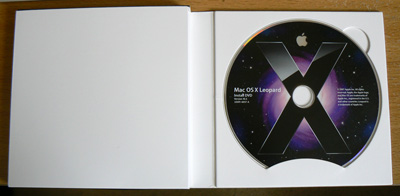 Like the iLife and iWork packages Leopard has an elegant CD Jewel Case sized box that contains a fold-out box with the DVD sitting on the right and the manual, a sticker sheet, and licenses sitting in a box on the left.
Like the iLife and iWork packages Leopard has an elegant CD Jewel Case sized box that contains a fold-out box with the DVD sitting on the right and the manual, a sticker sheet, and licenses sitting in a box on the left.
The DVD has the space theme of the box printed on it as does the manual, which is very much akin to the manual that comes with iWork.
It’s nice to see a printed manual but like all Apple apps the online documentation is much fuller.
The DVD to IPad has everything on it from Leopard, XCode, and the Boot Camp drivers. This is much better than before, when Tiger had separate discs for the Operating System and XCode. Along with XCode comes DashCode and WebObjects, so you have an amazing development environment provided all for free. Beat that Microsoft !
Install is pretty much standard although the screens are ever so slightly different…but that doesn’t stop them from being any less intuitive. I performed two types of install, first an "Archive and Install" and secondly a complete "Erase and Install". This was mainly for testing purposes to see which made a difference. I wanted to see if anything broke doing "Archive and Install" and if those problems were fixed by doing a clean install or if they were caused by Leopard incompatibility.
I had no problems with "Archive and Install", with the exception being Parallels failing, but this may have been due to the pre-release Beta of Parallels I had installed beforehand. For all intent and purposes, it worked a charm. One thing you’ll notice that is different right from the word ‘Go’ is the Software Update system. The initial list of apps is the same but here’s what it looks like…
This a more minimalist approach is far nicer than the fuller window that we had with Tiger.
Let’s now look at the first things you’re likely to interact with when using Leopard.
Desktop
The second hit in the face is of course the Desktop. The menu bar is slightly translucent and this seems to irk a few people but I have yet to be bothered by it. Unlike Windows, the menu bar is always in the same place so you know where to go. I personally prefer to have the menu bar less in your face as I prefer to concentrate on what I’m doing rather than being distracted by something that I use only when I need it. This is what it looks like with a reasonably noisy sort of a photo:
I personally have no problems reading this and it’s far easier to read than the image portrays, but I guess it’s something that people may find irritating.
Another feature, while technically not part of the desktop, is the ability to scroll applications that aren’t the selected window. This allows you to scroll to text that you might wish to quote but saves the hassle of having to switch between windows all the time. A very nice inclusion.
Dock
Another controversial feature is the new Dock. Once again I love it, it’s better looking than the previous, actually takes less real estate than the previous Dock. One seriously cool thing is that if you move the Dock to the side the icons on your desktop will move accordingly. That’s a biggie because before if you moved the Dock to the right the Dock would sit over the drives. Now though the drives respect the Dock and are pushed over to the left.
One feature that takes a bit of getting used to is the small blue dot as opposed to the black arrow to indicate what is running. It can be a bit difficult to workout which apps are running but I think that’s something that will be worked out over time. The folder issue is a bit of a pain. Any folder on the right hand side of the Dock will show a collection of contents as opposed to the actual folder icons.
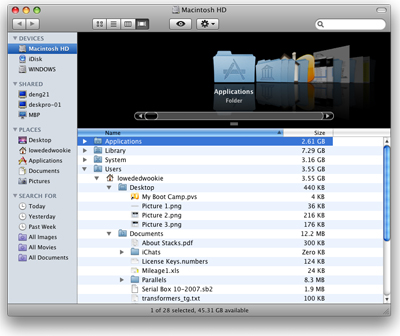 On clicking the icons on the right side of the Dock, it brings up a fan or a grid depending on how many entries are in each folder. Grid is the better display format, but fan can be just as good. These are called Stacks and I quite like. Some people don’t on account of them giving limited viewing if you have lots in a folder. I think this can be best reduced if you use smart folders and place these on the Dock.
On clicking the icons on the right side of the Dock, it brings up a fan or a grid depending on how many entries are in each folder. Grid is the better display format, but fan can be just as good. These are called Stacks and I quite like. Some people don’t on account of them giving limited viewing if you have lots in a folder. I think this can be best reduced if you use smart folders and place these on the Dock.
Finder
The Finder now looks very much like iTunes. Some say this is a bad thing but once again I disagree. It is better laid out, is more structured and the groupings is much better as well. I had always figured that the iTunes look would be moved to the Finder and now that it has I’m happier than a monkey in a banana tree.
CoverFlow is such a great idea. It makes it so much easier to see contents of files. One thing I’m not a fan of is that with CoverFlow on you only get the List view. I’ve always hated list view because it’s not that intuitive. Give me icon view or even column view and I’ll be much happier.
QuickLook is so awesome. Select an icon and press the spacebar and a quick preview of the document is opened. You can flick through pages of PDFs, albums, Word and Excel documents etc. You don’t need any apps installed to use QuickLook.
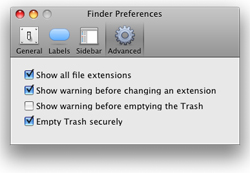 One thing you might have noticed with the image here is that the folders also have sizes listed beside them. This is a brilliant feature that has been finally added whereby it can automatically calculate the size of folders and tell you how big the folder is. This works great and is something Windows definitely does not have. Also, another hidden option is to have the Trash always perform a secure delete. This is fantastic for the paranoid but it will add some time to deleting due to the nature of what it does. It may still not be fail proof but it certainly makes it more secure.
One thing you might have noticed with the image here is that the folders also have sizes listed beside them. This is a brilliant feature that has been finally added whereby it can automatically calculate the size of folders and tell you how big the folder is. This works great and is something Windows definitely does not have. Also, another hidden option is to have the Trash always perform a secure delete. This is fantastic for the paranoid but it will add some time to deleting due to the nature of what it does. It may still not be fail proof but it certainly makes it more secure.
The icons for folders have changed and if you do a magnify you see that they are made of recycled paper. That’s got to be a kick in the danglies for GreenPeace who seem to have a love-hate relationship with Apple. I think the understated nature of the icons are nice.
Screen Capture
One interestingly cool feature is when you go to do a screen grab using Command-Shift-4. You now get a crosshair with X/Y co-ordinates showing up at the bottom right of the arrow. This makes things so much more precise and is a fantastic feature. Unfortunately I couldn’t get a screenshot to show you what it looks like.
Spotlight
Whoever Apple hires to come up with ideas needs to be given a medal for rolling Dictionary and Calculator into Spotlight. Now if you want to do a quick and dirty calculation you don’t need to open Calculator (or use the lesser widget) to do so. Simply type the equation into Spotlight and bingo bango bongo results, and you can even do complex BODMAS (or BOMDAS depending if you’re old or not) equations as well. In fact look at the difference in the next two equations (both are correct):
This is a feature I will make full use of. {xtypo_quote_right}The simplicity of Time Machine is the reason that this is a revolutionary product. It completely changes the way we think about backups…
Searches are very quick as well, something people have made a note of. This is because of indexing that may take some time initially on slower machines as it indexes your whole machine. Once the index is finished it will only index what has changed from then on.
Spotlight has also been integrated into the Help system and offers a really neat feature where if a command is accessible from the menu bar then it will highlight that option.
This is in addition to the actual help files. A nice feature I have to admit.
System Preferences Firewall
Don’t look under Sharing for the Firewall options as they are now under Security. And it’s more powerful whilst being simpler. You can either allow all, block all, or set access based on application as can be seen in the image.
This approach to network security is a much better approach than the "let everything in and deal with it later" approach to just about every firewall out there. By blocking everything but the stuff you actually want you make, it makes it more difficult for hackers to access your machine. It’s not foolproof, but a lot better than other ways.
Networking
The initial interface has changed to a cleaner more concise layout with much more information. The advanced options include some more networking options that allow the Mac to communicate better with Windows networks, for example there is now a WINS option.
Although WINS is getting less and less usage due to DNS being the default standard for networking addressing now, some Windows servers (NT4 and Win2K mainly) may require WINS addresses. Interestingly DNS and TCP/IP have been separated and DNS now has the ability to get DNS entries from Domains, which I’m assuming includes Windows Domains. AppleTalk is still there which is odd, but I guess there are still some old Mac OS 9 servers out there or machines that require AppleTalk.
Printer & Fax
Another really nice change is to the Printing preferences panel. There is no Printer Utility and has instead been rolled into a single section of Preferences where it belongs quite frankly. I had no problem whatsoever with setting up my Epson CX4700 multipurpose printer. Plugged it in and Leopard picked it up automatically. But wait there’s more. Not only did it pick up the printer it also installed the scanner part automatically as well. It’s even got a much nicer scanner interface than the Epson drivers, and yes the scanner can be shared over the network.
Parental Controls
Parental Controls is a new addition and is a good idea to be able protect children through restrictions. It would be nice to allow this to be used for everyone but the default account is an administrator and Parental Controls can’t be used on that account. It’s a shame because some features should be available to all users like for example profanity filters, porn blockers, etc.
You can set application access, limit e-mail and chat usage, set times that they can login and use logs to track usage. Parental Controls is a wonderful addition to help keep our kids safe and even protect other users to the machine.
Aside from these the System Preferences pretty much retains the same features although Sharing has been trimmed a bit due to the aforementioned relocation of Firewall.
Spaces
Spaces is nothing new and has been around for years on the UNIX platform. Apparently Windows had it but as always, Microsoft screwed it up and it was rarely implemented.
Put simply Spaces gives you multiple desktop environments, up to 16 in all. You can group applications or assign an application a Desktop for itself. If you use the new Apple keyboard you will need to press ‘Fn F8′ to kick it in action or you can press Control 1 – 9. I have Spaces set on the menu bar but to be truthful I kind of prefer just clicking the Dock icon. Spaces is the best implementation of this sort of tool I have seen. It’s a better implementation that most UNIX environments because it offers more spaces.
The Dock and Desktop stays the same in all Spaces but what’s cool is the little transition animation that lets you know you’re going somewhere else.
One thing I dislike about Spaces is the inability to automatically assign apps to a particular space permanently. You have to manually do this each time you open an app. It’s a bit of a pain but nothing major I suppose.
Time Machine
The most revolutionary (yes it is Mr Mossberg) feature of Leopard is Time Machine. Put simply it’s backups for idiots. All you have to do is simply tell it which drive you want for backups and it will do everything itself. It does incremental backups every hour which is good because chances are you will screw something up within the first hour. It will perform a daily backup, a weekly backup and a monthly backup. Put simply, you will have backups out the wazoo and you’ll never be happier.
It’s best to have a drive solely dedicated to backups as it will fill up pretty quickly. This is a good thing as it does some serious butt saving.
The simplicity of Time Machine is the reason that this is a revolutionary product. It completely changes the way we think about backups and as such more and more people will be using this feature thus the attitude towards backups will have changed. Once again, this is by definition revolutionary.
As cool as this sounds it’s a ‘behind the scenes’ app that you never have to worry about. As such there’s nothing really to mention. Oh sure it’s so dead easy to restore a file but aside from that it’s pretty much fire up and forget. When you need it though, you’ll be glad you had it running.
iSync
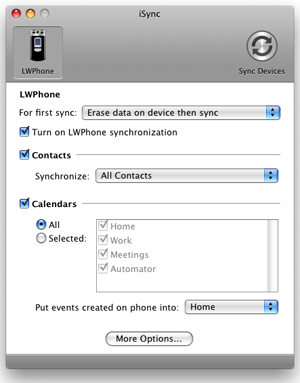 iSync is a must have app for anyone wanting to organise themselves on the fly. It’s most noticeable change is the removal of the .Mac synching which is solely handled by System Preferences now (although backend wise it’s still iSync).
iSync is a must have app for anyone wanting to organise themselves on the fly. It’s most noticeable change is the removal of the .Mac synching which is solely handled by System Preferences now (although backend wise it’s still iSync).
If I could have one wish it would be to have iSync synch with Palm devices without having to us Palm Desktop. It seems like a bad solution to have iSync conduits installed to allow Sync Services in Mac OS X and iCal and Address Book communicate with a Palm device. It would be so much tidier to do it all through iSync and its more system friendlier experience.
iSync communicates well with most Vodafone phones but Telecom phones are not so lucky…although Nokia do supply plugins from their site, only not for the phone work gives me, which sucks (although my work phone is a joke because it doesn’t even sync the notes for Calendars under Outlook so it’s usefulness is pretty much zero).
iSync is a constant companion for me with my Palm. I never ever use Palm Desktop. All my Address Book is uploaded to my Sony Ericsson v800i with no issues at all.
While much of the changes are cosmetic tidy-ups within iSync, the application is a lot nicer for it. That being said though I tend to just have the iSync icon on my menu bar do the work, so I don’t venture much into the app at all. Apple designed a tool so powerful that it’s not even needed. Brilliant.
Disk Utility
Disk Utility is amongst the applications, enhancements and utilities that has seen some off the most powerful changes in Mac OS X Leopard.
For all intent and purposes it looks the same only with the refined layout that is across the board with the other windows. But Disk Utility has a supremely powerful feature in that it can actually resize partitions on the fly. This means you can repartition without having to boot into the Install disk to alter the boot partition.
It can do this by taking the free space and making another partition out of it. This is a seriously handy thing to be able to do and once again is something that can’t be done on Windows, at least without 3rd party apps like Partition Magic.
You’ll see that the partition is separated into two bits, a blue bit and a white bit. The white bit is the free space and so you can use that as much as you like. The blue bit is what’s used and this cannot be altered.
Terminal
Terminal has had a makeover. It looks like a normal Shell window but it now has tabbed windows which makes it perfect for multitasking.
Better yet it has a feature called Secure Keyboard Entry which prevents keyloggers from recording your keystrokes. This alone can make Leopard more secure as it means that passwords can’t be captured by keyloggers either.
On thing that I’d prefer to see is X11 merged with Terminal. It seems dumb having two terminal style apps instead of one. Actually I’d prefer X11 apps to run natively but this isn’t going to be an easy ask. Maybe in Mac OS X 6?
X11
Actually while we’re on the subject of X11 one thing that’s different is that X11 is installed by default rather than being an option. It’s now optional to turn it off.
Considering apps like Gimp (doesn’t run well), OpenOffice and the like require it to run, it makes sense that it would be installed so that people don’t have to worry about installing another app. Once again I’d prefer this to be rolled into Terminal because it can be a pain to get things like Fink or Darwin Ports working with X11 but the fact it’s there by default is nice.
Automator
Automator is one of those apps that seems like you’ll never need, but you then find out how cool and intuitive it is and inevitably end up using it a lot.
The version in Leopard has a really nice feature called "Watch Me Do" which is as it sounds. Basically it follows your every movement and records it as a macro, which you can then re-use as an automator script. On using it I find it is more along the lines of ScriptIT on Windows than the much cooler and nicer XenWorks under Novell. That being said this has the potential to make your life so much simpler.
I set up a workflow that sets the System Volume to Full, opens iTunes, and then starts playing my Favourites playlist. This workflow was made using nothing but the internal commands…but I had a problem. There’s no command for stopping iTunes from playing. So I used Watch Me Do to record a macro that clicked on the iTunes icon on the Dock then pressed Command Q to close iTunes down. In both cases I saved these as iCal plugins which then allowed me to set times to execute these macros. I set the Wake Up one to 6:00AM then I set the Close iTunes one to 6:15AM. So now I have a fully functioning alarm clock.
Automator is definitely a powerful app but its power (as with most Apple apps) is made very simple with nothing more than dragging and dropping in many cases. Watch Me Do can take a bit of getting used to, but once mastered, will make your life so much better.
Dictionary
Of all the apps that should be the most beneficial, this turns out to be the most worthless.
Don’t get me wrong, it’s a brilliant application and is very handy…but the fact that Apple decided only to include the New American Oxford Dictionary instead of also giving us the ‘proper’ version as well is kind of an insult to the English language.
I’m sorry but I live in New Zealand and I was taught the Queen’s English at school. So whilst spelling systems allow you to get around the issue via language settings (such as choosing ‘British English’) it is odd to find that the actual Dictionary doesn’t allow this.
Leopard now includes a grammar checker. Personally I have a love hate relationship with grammar checkers in that I love to hate them. Rarely do they get it right or take into consideration regional dialect, so while many rave about this feature I never turn it on.
But that’s not to say that this isn’t actually a handy app, as it does allow you to search Apple and Wikipedia as well. The Apple aspect is obviously good for developers and the Wikipedia aspect makes Dictionary a quick and dirty encyclopaedia.
What’s a bit naff is that if you searched for Zealand it only tells you about an island province in the Netherlands. It doesn’t even think about offering New Zealand as a definition either. What is dumb however is that the island actually isn’t called Zealand but is correctly spelled Zeeland, Zealand is of course the English spelling of it. Wikipedia also gets this wrong unless you search for Zeeland in which case it gets it right.
All in all Dictionary is a blessing and a curse so take it as you will.


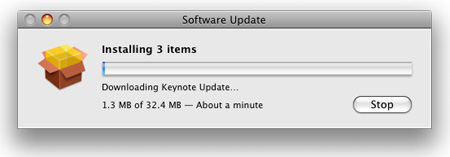
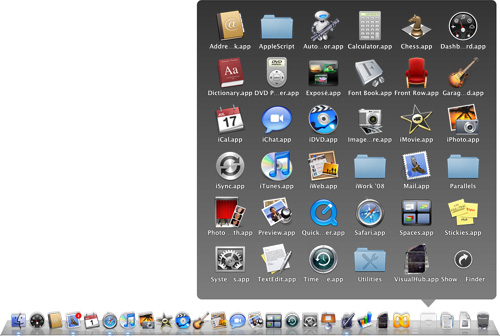

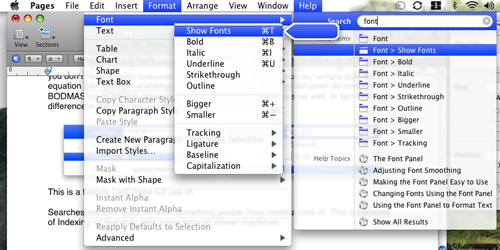
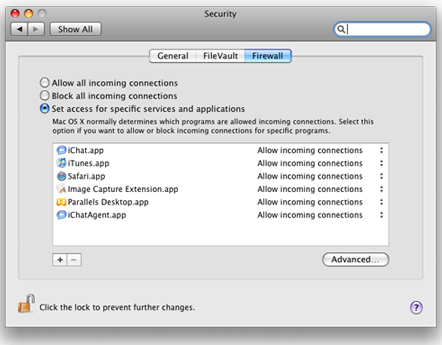

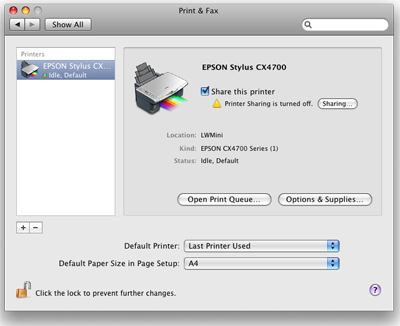
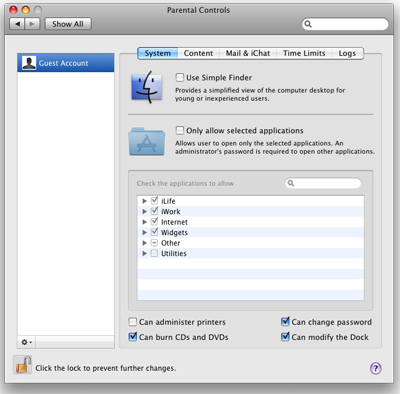
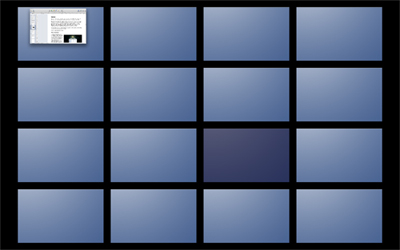

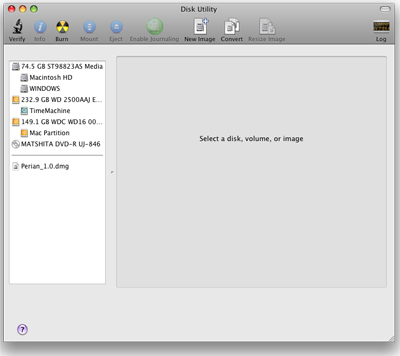
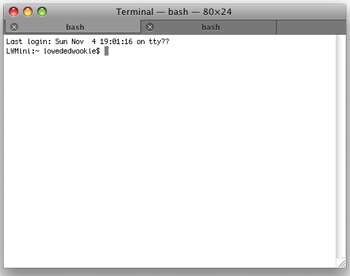
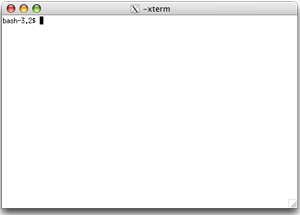
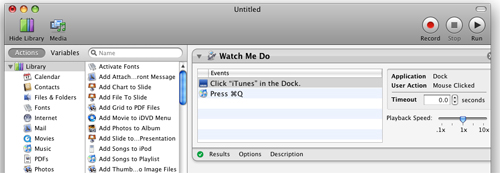
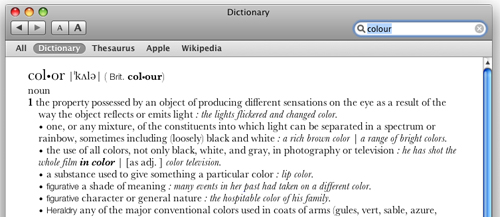
No comments
Be the first one to leave a comment.